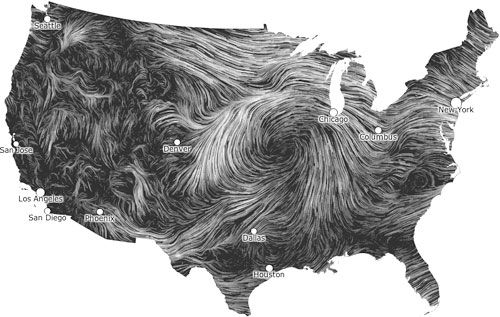 |
| Frame from "Wind Map" Martin Wattenberg and Fernanda Viegas |
Last night, I attended the second presentation in this season's Art, Technology, and Culture Colloquium series at UC Berkeley. Martin Wattenberg and Fernanda Viegas, artists and researchers who often work as a team, presented "Visualization and the Joy of Revelation," an engaging survey of their greatest hits (to date) supplemented by tidbits about their process and working philosophy.
From the ATC listing:
"Fernanda Viegas and Martin Wattenberg explore the joy of revelation: the special electricity of seeing a city from the air, of hearing a secret, of watching a lover undress. Their medium is data visualization, a technology developed by computer scientists to extract insights from raw numbers. They'll show what happens when this technology is aimed at data sets that range from tropical storms to social networks, from arguments on Wikipedia to expressions of carnal desire."As Wattenberg and Viegas showcased some of their work -- "Fleshmap" and "Wind Map" are perhaps the best known of their collaborations -- I found myself thinking about one of the books I'm currently reading, astrophysicist Adam Frank's The Constant Fire. In the book, Frank critiques the current relationship (or lack thereof) between science and religion, arguing that the spiritual impulse is at the root of both religion and science (i.e., that religion is a kind of proto-science). Riding BART to Berkeley from San Francisco, I was struck by the passage below and Wattenberg and Viegas' presentation called it to mind.
"Science […] makes life's sacred character apparent to us. Science creates hierophanies through the act of careful observation and consideration. Science makes even the smallest thing - the gnat, the flea, the dust mote - sacred. This transformation comes about when the observer cares enough to notice the world's details. The experience […] comes in the moment when we encounter a new image or recognize the key patterm in a new dataset. It comes whenever the patheways of science make the world stand out, illuminated and luminous. […] It is a result of an encounter with the world when it is allowed to speak for itself. In hearing its voice we see the world as new and worthy of awe. […] If, as a culture, we do not identify this moment as an encounter with the world's sacred character, as a hierophany, it is because we have been taught not to. Instead we call it 'amazement,' 'wonder,' or simply 'awe.' We should not be fooled. Rudolf Otto would not be fooled. In The Idea of the Holy he named 'awe' as nothing less than the principal experience of the numinous."Wattenberg and Viegas exhibit a curiosity and enthusiasm (it's worth exploring the etymology of the second word) that is shared by many of the strongest artists, scientists, and thinkers. All the ink spilled about the intersection of art and science notwithstanding, the seed from which both sprout is watered by amazement, wonder, and awe. Individually, most of us prefer to experience those emotions in either a sacred or a profane arena, but Frank's point is that the arenas themselves are constructions; in this respect, sacred and profane are functionally the same.
The projects Wattenberg and Viegas have created hammer that point home. Explore some of them below.
The Wind Map
Fleshmap
(For a good chuckle, visit the musical genres breakdown of this project.)
Flickr Flow
History Flow
 |
| Frame from "Flickr Flow" Martin Wattenberg and Fernanda Viegas |
Image credits: both images ripped from Martin Wattenberg's website, visualizations by Wattenberg and Viegas

No comments:
Post a Comment